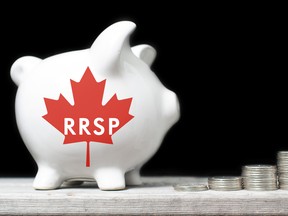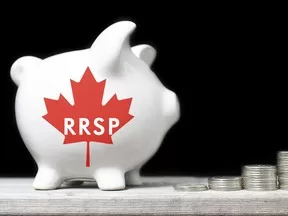Reviews and recommendations are unbiased and products are independently selected. Postmedia may earn an affiliate commission from purchases made through links on this page.
Here’s how small business owners can make the most of RRSPs, both now and in future years

Article content
Each year at this time, business owners are presented with a critical financial opportunity: the ability to contribute to a registered retirement savings plan for the preceding tax year — in this case, the 2023 tax year — with a contribution limit of 18 per cent of your previous year’s earned income, capped at $30,780.
Even if you can’t fully leverage it right away, Feb. 29 is an important deadline for business owners with sole proprietor income or incorporated T4 income. Either way, it’s worth learning and planning ahead for how you can regularly make the most of it. Let’s dive in.
Advertisement 2
Article content
Article content
Understanding RRSPs
RRSPs are a cornerstone of retirement planning in Canada, offering a tax-deferred way to save for your future. This is particularly important for self-reliant business owners who, unlike a corporate or government employee with a pension plan, must navigate both current business cash flows and post-exit financial stability.
Taking it a step further, this becomes vital for those whose business structure may not lend itself to a third-party sale sufficient enough to pay for life after work, making ongoing personal retirement planning essential.
The amount you contribute to your RRSP is deducted from your taxable income, potentially placing you in a lower tax bracket. Remember, the exact amount you can contribute is detailed in your personal tax notice of assessment.
3 advantages for business owners
Tax reduction: Contributing to your RRSP before the deadline is an effective way to reduce your taxable income for the year. Especially for business owners, whose income may fluctuate, this can translate into significant tax savings.
Income smoothing: The flexibility of the RRSP program allows you to contribute more in high-income years and carry forward unused contribution room to years when your income might be lower. This income smoothing can optimize your tax situation over several years.
Article content
Advertisement 3
Article content
Compound growth: RRSPs offer the benefit of tax-deferred growth. This means that any investment gains in your RRSP will not be taxed as long as they remain in the plan. Over time, this compounding effect can substantially increase your exit paycheque — that is, your retirement savings payout.
Why contributing now matters
Even if you haven’t been regularly contributing throughout the year, making some contributions (however modest) before the deadline can help. Here’s why:
Immediate tax relief: Contributions made before the deadline can be deducted from your 2023 personal taxable income, offering immediate tax relief.
Last-minute contributions count for compound growth: Even last-minute contributions can have a significant impact on reducing your tax bill and boosting your savings for retirement over the long term.
3 ways to maximizing your contribution
Assess your finances: Review your financial situation to determine how much you can contribute. Remember, it’s not just about reaching the maximum limit, but about what makes sense for your current financial status. Even small amounts count.
Advertisement 4
Article content
Plan for the future: While focusing on the immediate tax year is important, consider your long-term, post-exit income and wealth accumulation goals as a business owner. RRSPs are a marathon, not a sprint; consistent, thoughtful contributions will serve you better in the long run.
Seek professional advice: Given the complexities of tax planning and retirement savings, consulting with a financial adviser and your accountant can be beneficial. Together, they can help tailor your RRSP strategy to your unique business and personal financial situation.
Recommended from Editorial
Beyond RRSPs
For business owners with T4 income of more than $100,000 and over the age of 40, individual pension plans (IPPs) offer another layer of retirement planning. While beyond the scope of this article’s RRSP deadline, it’s worth noting that IPPs can provide higher contribution limits and additional tax benefits.
Making the most of your RRSP contribution before the deadline is a smart and strategic financial move. It offers immediate tax benefits and sets the stage for a more secure financial future. So, review your finances, understand your contribution limits and if you haven’t already, take advantage of this opportunity to invest in your future. Remember, every contribution counts in the world of retirement planning, and the best time to act is now.
Colleen O’Connell-Campbell is a wealth adviser at RBC Dominion Securities Inc. and creator of the Cash-Rich Exit podcast.
Article content



